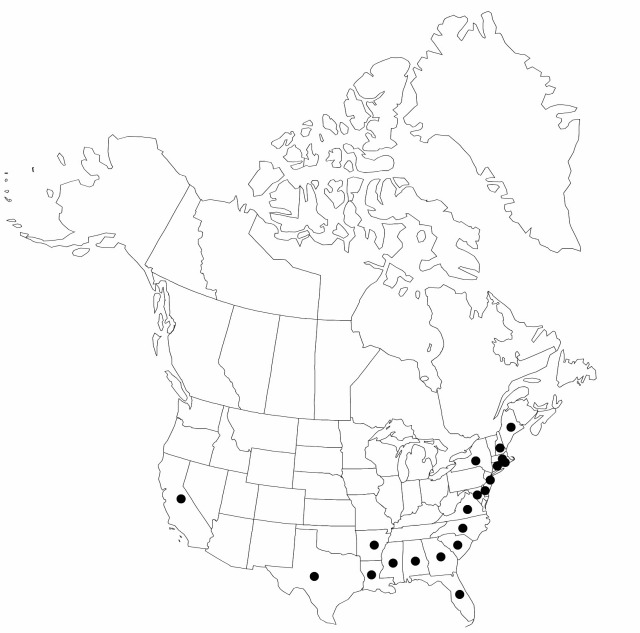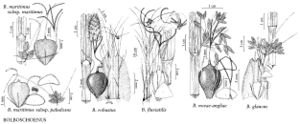Difference between revisions of "Bolboschoenus robustus"
Cas. Nár. Mus., Odd. Prír. 141: 63. 1972.
FNA>Volume Importer |
imported>Volume Importer |
||
| (2 intermediate revisions by 2 users not shown) | |||
| Line 8: | Line 8: | ||
}} | }} | ||
|common_names=Seacoast bulrush | |common_names=Seacoast bulrush | ||
| + | |special_status={{Treatment/ID/Special_status | ||
| + | |code=F | ||
| + | |label=Illustrated | ||
| + | }} | ||
|basionyms={{Treatment/ID/Basionym | |basionyms={{Treatment/ID/Basionym | ||
|name=Scirpus robustus | |name=Scirpus robustus | ||
| Line 57: | Line 61: | ||
|publication title=Cas. Nár. Mus., Odd. Prír. | |publication title=Cas. Nár. Mus., Odd. Prír. | ||
|publication year=1972 | |publication year=1972 | ||
| − | |special status= | + | |special status=Illustrated |
| − | |source xml=https:// | + | |source xml=https://bitbucket.org/aafc-mbb/fna-data-curation/src/2e0870ddd59836b60bcf96646a41e87ea5a5943a/coarse_grained_fna_xml/V23/V23_58.xml |
|genus=Bolboschoenus | |genus=Bolboschoenus | ||
|species=Bolboschoenus robustus | |species=Bolboschoenus robustus | ||
Latest revision as of 20:41, 5 November 2020
Culms 50–150 cm × 4–8 mm. Leaves: sheaths reaching beyond middle of culm, fronts usually convex, papery at mouth, veins reaching margin, or occasionally membranous with veins diverging proximal to apex leaving triangular, veinless area; widest blade 4–12 mm wide. Inflorescences simply branched with 1 or not more than 1/2 of spikelets solitary or in clusters of 2(–3) on 1–7 rays, rays not exceeding 7 cm; involucral bracts that surpass inflorescence 2–4, widest bract 2–7 mm wide. Spikelets (1–)5–25, broadly ovoid to rarely lanceoloid, 10–30 × 6–10 mm, base usually truncate; scales usually tightly imbricate, medium to dark orange-brown, lineolate-spotted at 15X, usually 6–9 × 3–4 mm, papery and nearly opaque, rarely membranous, apex 2-fid, 1 mm deep, awn very stout, 2–3 × 0.5 mm at base. Flowers: perianth bristles not persistent on shed achene or 1–2 weakly attached to shed achene, dark red-brown, 1/2 achene length; anthers brownish orange, 1.5–2.5 mm; styles (2–)3-fid. Achenes dark to medium brown, obovoid, compressed-trigonous with broadly rounded abaxial angle or sometimes biconvex, 2.7–3.5 × 1.8–2.8 mm, apex truncate to broadly rounded, beak 0.1–0.3 mm, surface glossy, exocarp cells evident at 10–20X; in achene cross section exocarp 2 times thicker than mesocarp and its cells greatly enlarged, 3 times or more deeper than wide; achene specific gravity much less than water.
Phenology: Fruiting spring–fall (south), summer (north).
Habitat: Brackish to saline coastal (very rarely inland) shores and marshes
Elevation: 0(–100) m
Distribution

Ala., Ark., Calif., Conn., Del., Fla., Ga., La., Maine, Md., Mass., Miss., N.H., N.J., N.Y., N.C., R.I., S.C., Tex., Va., Mexico, South America.
Discussion
The only known noncoastal localities of Bolboschoenus robustus are in Arkansas, Louisiana, and southeastern Texas. On the Gulf Coast B. robustus sometimes has a triangular, membranous, veinless area in the mouth of the leaf sheath, which is typical of B. maritimus.
The name Bolboschoenus robustus has been erroneously used for both B. maritimus and B. robustus in most literature on the flora of the Pacific coastal states. Putative hybrids of B. robustus with B. maritimus are common in zones of sympatry; they often have long-lanceolate spikelets. The type of Scirpus maritimus forma agonus Fernald is probably a B. maritimus × B. robustus hybrid. Bolboschoenus novae-angliae is probably derived from B. fluviatilis × B. robustus (J. Browning et al. 1995). Putative B. maritimus × B. robustus hybrids are known from New Brunswick and Nova Scotia, north of the known range of B. robustus (J. Browning et al. 1995).
Selected References
None.
